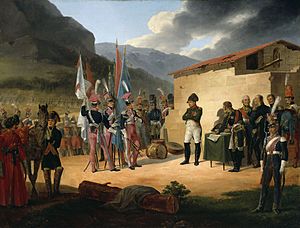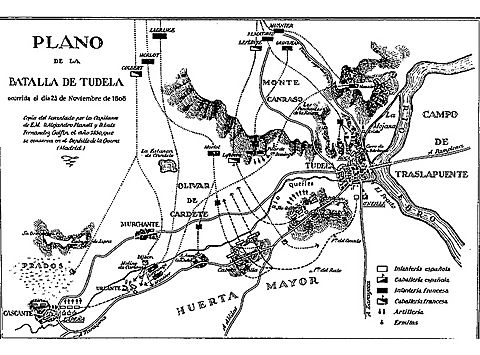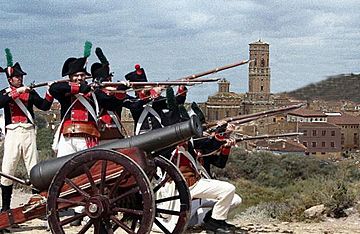Battle of Tudela facts for kids
Quick facts for kids Battle of Tudela |
|||||||
|---|---|---|---|---|---|---|---|
| Part of the Peninsular War | |||||||
 Battle of Tudela January Suchodolski, National Museum in Warsaw |
|||||||
|
|||||||
| Belligerents | |||||||
| Commanders and leaders | |||||||
| Strength | |||||||
| 35,000 | 45,000 | ||||||
| Casualties and losses | |||||||
| 700 | 6,000 | ||||||
The Battle of Tudela happened on November 23, 1808. It was a big fight between the French army, led by Marshal Jean Lannes, and the Spanish army, led by General Castaños. The French army won a complete victory. This battle took place near Tudela in Navarre, Spain. It was part of the Peninsular War, which was itself a part of the larger Napoleonic Wars.
Contents
Why the Battle Happened
Napoleon's Plan for Spain
The French invasion of Spain had already begun. Napoleon, the French emperor, had a clear plan. He wanted to attack the city of Burgos very strongly. This would split the Spanish armies apart. Then, he planned to send his troops north and south to surround them.
Getting Ready for Battle
Spanish Army Movements
On November 21, 1808, General Castaños was near Calahorra. This town is on the Ebro River, between Logroño and Tudela. On the same day, a French army group, called the III Corps, crossed the Ebro at Logroño. They started moving east towards Calahorra. At the same time, another French group, the VI Corps, led by Marshal Michel Ney, headed towards Tudela.
These French movements put Castaños in a difficult spot. He was in danger of being trapped between the two French armies. To avoid this, Castaños pulled his troops back to Tudela. He decided to defend a long line, about 17 kilometers (10.5 miles) long. This line stretched from Tudela west along the Ebro River. It then followed the Queiles River to Cascante and ended at Tarazona.
Spanish Commanders and Positions
Castaños did not have enough soldiers to defend such a long line. So, he asked General Juan O'Neylle for help. O'Neylle had two divisions (groups of soldiers) at Caparroso, on the east side of the Ebro. But O'Neylle was under the command of General Palafox. He refused to move without Palafox's direct order. This order did not arrive until noon on November 22.
O'Neylle quickly moved his troops to the east bank of the Ebro, across from Tudela. However, he decided not to cross the river until the next day. By the evening of November 22, Castaños had nearly 45,000 soldiers near Tudela. But most of them were not yet in their fighting positions.
Castaños placed General Manuel la Peña's 4th Division at Cascante. This group had 8,000 men, many of whom had fought in the Battle of Bailén. General Grimarest was at Tarazona with three divisions, about 13,000 to 14,000 soldiers. General Roca's division was on the east bank of the Ebro. Also there were two divisions from Aragon, led by O’Neylle and Felipe Augusto de Saint-Marcq.
Most of the fighting at Tudela would involve only Roca's, O'Neylle's, and Saint-Marcq's divisions. These three groups had about 23,000 infantry soldiers.
French Army Strength
For the French, only the III Corps was involved in the Battle of Tudela. Before November 22, Marshal Moncey commanded this force. But Napoleon gave command to Marshal Jean Lannes when the attack began. This corps had almost 34,000 men. It included four infantry divisions and three cavalry groups. General Joseph Lagrange's infantry division and General Auguste François-Marie de Colbert-Chabanais's cavalry were also added. These came from Ney's corps.
On the night of November 22, the French army camped at Alfaro. This town is about 17 kilometers (10.5 miles) up the Ebro from Tudela.
The Battle Begins
On the morning of November 23, 1808, Lagrange's infantry and two cavalry groups moved towards Cascante. The rest of the French army went along the Ebro towards Tudela.
At this time, O'Neylle was still trying to get his three divisions across the Ebro River. Roca's division crossed first. It reached its position on the right side of the Spanish line just as the French attacked. Saint-Marcq's division crossed second and also got into position before the attack.
By the time O'Neylle's own division was crossing, they had to fight French skirmishers. These French soldiers were already at the top of the Cabezo Malla ridge.
First French Attack
The first French attack was not well-organized. It was carried out by their leading soldiers. They realized the Spanish were not fully in position. Even though the Spanish pushed back this attack, it showed how weak their positions were. There was a 5-kilometer (3-mile) gap between Castaños's main force and La Peña's troops at Cascante.
The battle's outcome would depend on La Peña and Grimarest. By noon on November 23, they had received orders to move. La Peña was told to close the gap at Tudela. Grimarest was ordered to move to Cascante. Both commanders failed to follow these orders. La Peña only moved two small groups of soldiers to Urzante. La Peña's slow actions allowed two French cavalry groups to keep him stuck in place.
Second French Attack and Spanish Collapse
The second French attack was much stronger. On the French left, General Antoine Morlot's division attacked Roca's division. This was on the hills above Tudela. On the French right, General Maurice Mathieu's division attacked the smaller O'Neylle division head-on. They also tried to go around the Spanish side. Both attacks were successful. The French pushed both Spanish divisions off the ridges they held.
Then, the French cavalry, led by General Charles Lefebvre-Desnouettes, charged into the gap. This was the space between Roca's and Saint-Marcq's divisions. This charge caused the Spanish right side to completely fall apart.
La Peña and Grimarest finally joined forces at Cascante late in the day. They had about 21,000 men. They were facing Lagrange's division, which had 6,000 soldiers, plus two cavalry groups. However, after the rest of the Spanish army was defeated, La Peña and Grimarest retreated after dark. Their poor performance was clear in the number of casualties. Only 200 Spanish soldiers were lost on their left side. But 3,000 were lost on the right, and 1,000 were taken prisoner.
Who Won and What They Lost
The Spanish army lost about 6,000 soldiers. This was out of a total force of 45,000. The French, on the other hand, lost only about 700 soldiers killed or wounded. They had a total of 35,000 men.
What Happened Next
The Spanish armies that escaped from Tudela went in two different directions. The Aragonese forces, who were on the right side, headed for Zaragoza. They would help defend that city in the Second Siege of Zaragoza, which started on December 20, 1808. The Spanish left side, which was mostly still together, moved towards Madrid to defend the capital city.
However, Napoleon moved even faster. After beating a small Spanish army at the Battle of Somosierra on November 30, 1808, he arrived in Madrid on December 1, 1808. Napoleon's plan worked. He successfully took control of Madrid.
Learn More




